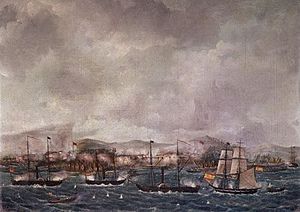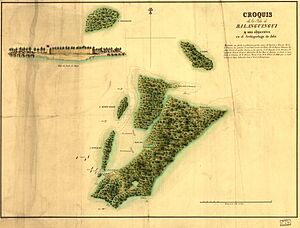Spanish expedition to Balanguingui facts for kids
The Balanguingui Expedition of 1848 was a big military operation. It was led by Governor General Narciso Clavería y Zaldúa to capture Balanguingui Island in the Sulu Archipelago. This island was a main base for Moro Pirates, who used it for their pirate attacks.
The expedition had 19 warships. They sailed from Manila and picked up more forces along the way. They reached Balanguingui on February 12. The island had four strong forts. After landing near one fort, the ships fired their cannons, and soldiers attacked. They successfully captured the first fort.
Three days later, the second and biggest fort, along with a smaller one nearby, were taken in a tough fight. On February 21, the last fort was captured easily. The campaign ended soon after. This was a major defeat for the pirates. The colonial forces captured four forts and several villages, which they burned. They also destroyed more than 150 proas (pirate boats). About 550 people who had been captured by the pirates were set free during the operation.
Quick facts for kids Balanguingui Expedition |
|||||||
|---|---|---|---|---|---|---|---|
| Part of Piracy in Asia | |||||||
 Naval bombardment of Balanguingui, by Fernández Muñoz. |
|||||||
|
|||||||
| Belligerents | |||||||
| Moro Pirates | |||||||
| Commanders and leaders | |||||||
| unknown | |||||||
| Strength | |||||||
| 19 warships | Land: ~1,000 pirates 124 artillery pieces 4 forts Sea: ~150 proas |
||||||
| Casualties and losses | |||||||
| 229-237 killed or wounded | ~450 killed 6 captured ~150 proas sunk 124 artillery pieces captured |
||||||
Contents
Why the Expedition Happened
By the mid-1800s, the southern part of Mindanao and the Philippines was a common hiding place for Muslim pirates. These pirates often attacked the coasts, looking for valuable goods and people to capture. They would then sell the captured people in the market of Jolo.
The government wanted to stop these pirate attacks. So, starting in 1843, they sent several expeditions to pirate bases. One of the most important expeditions was led by Narciso Clavería y Zaldúa. He was the governor-general of the Spanish colony.
Preparing the Fleet
In early 1848, Governor-General Clavería put together a fleet of 19 warships in Manila. This fleet was led by Brigadier José Ruiz de Apodaca. It included two steamers, two schooners, three brigs, and many smaller boats like gunboats.
Three companies of regular soldiers joined the ships on January 27. More soldiers, police, artillery experts, and engineers also came aboard later. The main ship of the fleet was the steamer Reina de Castilla. The fleet gathered more transport ships at Daitan. On February 17, they sailed towards Balanguingui, a major pirate base. On the way, the fleet got even more help from local Filipino boats called vintas and 150 helpers from Zamboanga.
Balanguingui Island: A Pirate Stronghold
Balanguingui was a small island, about 6 square miles in size. It was covered with thick mangrove trees and jungle. The land was very flat and swampy. When the tide came in, only a few sandbanks stayed dry. Four forts stood on these dry sandbanks, surrounded by houses built on stilts.
A shallow channel cut the island into two parts. This channel also had many smaller branches that went deep into the island, making Balanguingui a confusing, swampy maze. The four forts were named Sipac, Balanguingui, Sungap, and Bocutingol. The forts called Sipac and Balanguingui were the largest. They were located at the end of the biggest water channel. Their walls were made of tree trunks that were 2 to 3 feet thick and 18 to 20 feet tall. These walls were made even stronger with fences and stone barriers.
The Expedition in Action
Taking Fort Balanguingui
Early on February 16, the soldiers landed. They took advantage of the low tide, which connected the fort to the land. Several companies of regular soldiers and 150 experienced helpers from Zamboanga landed. Some groups were tasked with capturing the fort, while others were kept as a backup force.
Two steamers and two schooners, along with smaller boats, started firing cannons at the fort. Once the constant firing had weakened the pirates' spirits, the soldiers launched their attack.
The soldiers needed special hooks to climb the fort's tall walls. Even though the pirates fought hard with rifles, grenades, spears, and stones, the colonial forces managed to climb the walls and get inside the fort. About 25 pirates were killed inside. Another 30 or 40 jumped into the water and either drowned or were shot by the Spanish boats. The soldiers captured 14 cannons. The colonial forces lost 5 soldiers and 2 helpers killed, and about 50 were wounded.
Capturing Fort Sipac
The colonial forces then tried to move deeper into the island using the channel. However, there wasn't enough water for the Spanish boats. So, Clavería decided to attack Fort Sipac. He checked out the fort and realized that the naval ships couldn't get close enough to surround it. He ordered two small mountain howitzers to be set up on the narrow strip of land.
At dawn on February 19, the naval forces got into position. They started firing at 7:00 AM, at the same time as the land cannons. An hour later, the attacking groups, which included a naval team and 50 grappling hooks, began their assault. They shouted "Viva la Reina!" (Long live the Queen!). The pirates fired many rifles, but the soldiers managed to cut down wooden barriers and enter the fort. In their desperation, some pirates killed their own families or rushed at the Spanish soldiers with bayonets. Many civilians were killed during the battle. About 150 civilians were captured by the Spanish and sent to a field hospital.
Near the main fort, hidden by a thick coconut grove, was a smaller fort. This fort had caused some injuries to the Spanish during the earlier fighting. Clavería gave Captain Gregorio Bárcenas and his carabineer company the job of capturing it. Only one Moro was wounded in this attack, and no Spanish soldiers were hurt. The Spanish captured 93 cannons from the two forts, most of them made of bronze. Thirteen more cannons were found in nearby houses. The colonial forces had many casualties: 16 killed, 124 wounded, and 22 bruised. Captain José María Ataide was killed, and two of Clavería's assistants were wounded, along with other officers. About 340 dead pirates were gathered and burned to prevent diseases from spreading.
The End of the Campaign
There was one last fort on the island still held by the pirates. Some people who had escaped told the Spanish that the pirates were making the fort's defenses stronger. They also showed Clavería and his men a secret way to approach the fort without being seen.
On February 21, Clavería sent a company of soldiers and some Zamboangan helpers to land at this secret spot. Their goal was to check out the area or, if possible, capture the fort. The soldiers advanced through water that was waist-deep and managed to surprise the fort.
The pirates, who didn't have much military experience, were caught off guard and ran away. They left the fort and 3 cannons for the Spanish. Another cannon was found in a nearby house. After this, two Spanish armed boats and some Zamboangan vintas entered the island's channels. They set fire to many pancos (garay) and other boats used by the pirates, about 150 in total. Meanwhile, the soldiers cut down between 7,000 and 8,000 coconuts. They also set fire to the seven villages on the island and took apart and burned the forts. Even though smaller Spanish boats watched during the nights to stop the remaining pirates from escaping, some managed to get away to Jolo or nearby islands. However, most of those who hid in the mangroves died from hunger and thirst.
What Happened Next
On February 25, the Spanish troops, along with the wounded, the prisoners, and the freed captives, got back on their ships. The fleet then sailed to Zamboanga. After a short stop at the islands of Tonquil and Pilas to tell the local people about the defeat of Balanguingui, the steamers arrived at Zamboanga on February 28. The rest of the ships followed a day later.
The success of the expedition was celebrated in both Zamboanga and Manila. Governor-General Clavería received a special award, the Cross of San Fernando. He was also given new titles: Count of Manila and Viscount of Clavería by Queen Isabella II of Spain.
Besides capturing pirate boats and cannons, about 250 captives were freed. The Spanish forces had between 229 and 237 casualties, with 22 killed. However, this victory greatly helped reduce the activities of the Moro pirates against Spanish areas in the region. Since the pirates had also affected Dutch areas nearby, the Dutch Governor-General congratulated Clavería on July 25, 1849. Thanks to the Spanish victory, trade in the area improved for a while. The pirates of the Sulu Archipelago were very scared when they heard that Clavería had "destroyed the island of Balanguingui and killed its defenders." In early 1849, there were rumors that pirates had reoccupied the island, but an expedition sent there found no large pirate force.
See also
 In Spanish: Expedición de Balanguingui para niños
In Spanish: Expedición de Balanguingui para niños
- Slavery in the Sulu Sea
- Alipin
- Spanish–Moro conflict
- Philippine–American War
- Cross border attacks in Sabah




